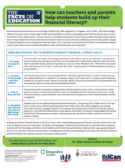How can teachers and parents help students build up their financial literacy?
Download the Fact Sheet! (254.36 kB / pdf)
DownloadAs the financial landscape becomes increasingly complex (e.g. debt repayments, mortgages, line of credit, retirement savings), children and youth require a wide range of skills and knowledge to be able to successfully make informed choices about money that will serve them well as adults. School is crucial in strengthening students’ financial literacy skills including practical lessons about money. Research has shown that financial education tends to improve financial confidence and increases positive changes in financial behaviour such as saving and investing money. This is important for overall financial freedom and wellbeing: feeling in control of your finances and having the flexibility to make choices that allow you to enjoy life.
HERE ARE FOUR KEY TIPS TO PROMOTE STUDENTS’ FINANCIAL LITERACY SKILLS:
1. It’s never too early to start
Financial skills are complex, but having conversations with children early on can help them understand the value of money. One easy way to teach this is to encourage them to think about what they could buy if they were to save their money, instead of spending it on toys or a treat. Metaphors like, “Money does not grow on trees, but if you put it in a bank, it could grow like a tree” are good ways of communicating about money to young children.
2. Teaching is not enough – practice matters
Learning through practice and receiving feedback, especially negative feedback, results in better learning than simply learning from a textbook. For example, using a mock credit card or creating a mock investment portfolio for students to track. Parents can also get children and youth involved with tracking household bills and expenses, which can help create healthy financial habits.
3. Make it easy and fun
Financial education can easily be integrated into existing subjects such as math or social sciences. Using games and apps can make learning about money more engaging and allow students to learn how to make informed decisions, receive feedback, and understand the consequences of their choices (whether positive or negative).
4. Recognize that the last two years of high school are crucial
Students will soon be making independent financial decisions. The last two years of high school is the right time to ramp up your efforts by getting specific about debit cards, bills, debt, budgeting, and savings. This is also the time to engage in deeper conversations about money and consider the social and cultural taboos (i.e. the belief that talking about money signals vulnerability or feelings of being judged) that prevent families from discussing money matters. Fostering openness will allow for better confidence in financial decision-making.
Building up students’ financial literacy is critical not only to their understanding of personal finances, but also to their role in the local and global economy as consumers, employees, and employers. Teachers and parents have an important role in equipping students with the knowledge and skills to make healthy and informed financial decisions. Setting simple, age-appropriate goals that focus on the value of money, the importance of budgeting and saving, and evaluating the consequences of financial decisions, sets the foundation for students to become financially confident adults.
Additional Information and Resources
Child and Youth Finance International: https://childfinanceinternational.org/
Financial Literacy in Canada: https://www.canada.ca/en/financial-consumer-agency/programs/financial-literacy.html
Global Financial Literacy Excellence Centre: https://gflec.org/
FuturFund: http://www.futurfund.org/
PlayMoolah: http://www.playmoolah.com/
References
Alsemgeest L. Talking about money is taboo: Perceptions of financial planning students and implications for the financial planning industry. Industry and Higher Education. 2016;30(6):394-401. doi:10.1177/0950422216670065
Amagir A, Groot W, Maassen van den Brink H, Wilschut A. A review of financial-literacy education programs for children and adolescents. Citizenship, Social and Economics Education. 2018;17(1):56-80. doi:10.1177/2047173417719555
Atkinson, A. and F. Messy (2013), “Promoting Financial Inclusion through Financial Education: OECD/INFE Evidence, Policies and Practice”, OECD Working Papers on Finance, Insurance and Private Pensions, No. 34, OECD Publishing, Paris, https://doi.org/10.1787/5k3xz6m88smp-en.
Blue, Levon, Peter Grootenboer, Mark Brimble (2014). Financial literacy education in the curriculum: Making the grade or missing the mark?, International Review of Economics Education, Volume 16, Part A, Pages 51-62, https://doi.org/10.1016/j.iree.2014.07.005.
Fernandes, Daniel & Lynch, John & Netemeyer, Richard. (2014). Financial Literacy, Financial Education, and Downstream Financial Behaviors. Management Science. 10.1287/mnsc.2013.1849.
Lusardi,A., OS Mitchell, V Curto (2010) Financial Literacy Among the Youth. Journal of consumer affairs, 44 (2), 358-380
Mandell L. (2008) Financial Literacy of High School Students. In: Xiao J.J. (eds) Handbook of Consumer Finance Research. Springer, New York, NY. https://doi.org/10.1007/978-0-387-75734-6_10
Sherraden, M.S., Johnson, L., Guo, B. et al. Financial Capability in Children: Effects of Participation in a School-Based Financial Education and Savings Program. J Fam Econ Iss 32, 385–399 (2011). https://doi.org/10.1007/s10834-010-9220-5
Soman, D (2017), Why financial Literacy should be taught in every school, The Conversation https://theconversation.com/why-financial-literacy-should-be-taught-in-every-school-88458
Te’eni-Harari, T. (2016), “Financial literacy among children: the role of involvement in saving money”, Young Consumers, Vol. 17 No. 2, pp. 197-208. https://doi.org/10.1108/YC-01-2016-00579

